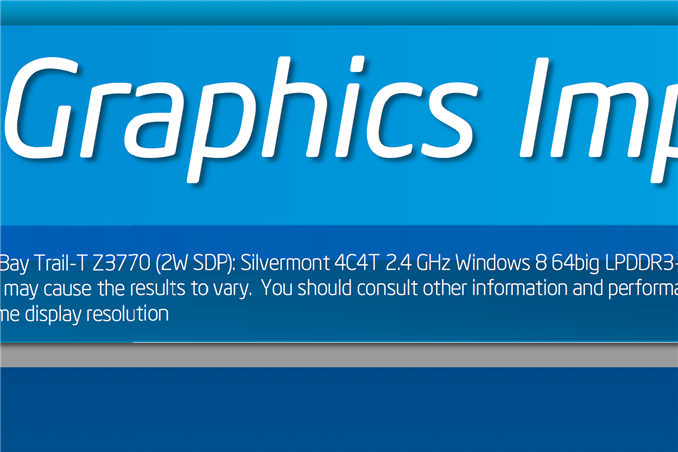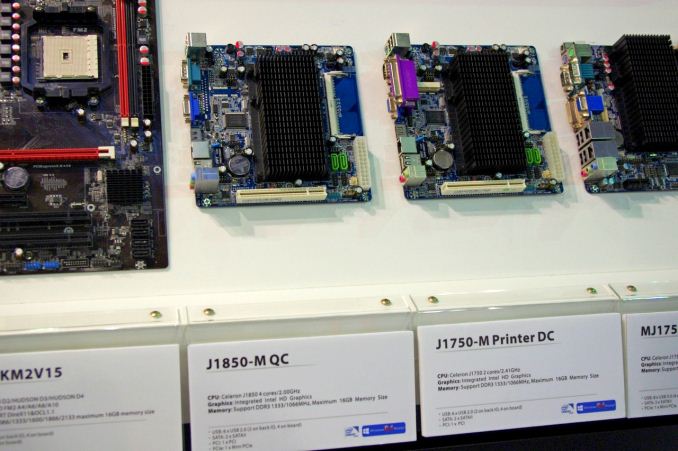Silvermont to Sell under Atom, Celeron and Pentium Brands, 2.4GHz Z3770 Leaked
by Anand Lal Shimpi on June 9, 2013 7:28 PM EST- Posted in
- CPUs
- Intel
- Atom
- Silvermont
- Trade Shows
- Computex 2013

During Computex a bit of Intel news leaked out that I didn't have time to talk about. Now that I'm back in the US, it's time to play catch up. As Silvermont is expected to drive up the performance stack, Intel will sell the core under Atom, Celeron and even Pentium branded processors. This is very similar to how AMD took Jaguar this generation and used it with both E-series and A-series branding.
Thanks to a great tip on Twitter (thanks Ashraf!), it looks like Intel's Hermann Eul (the new head of the mobile & comms group) leaked specs for the first official Silvermont SKU: the Z3770. It's unclear if this part will be branded Atom, Celeron or Pentium though. The quad-core SKU features a max CPU clock of 2.4GHz and carries a 2W SDP (Scenario Design Power) rating. Keep in mind that SDP is a thermal rating based on a different set of benchmarks than Intel's TDP ratings, so it's entirely possible for the chip to peak (and sustain) at higher thermals depending on usage model and how the OEM has configured the power profile of the chip. Previous generation Atom cores carried similar if not lower TDPs, which could mean that with Silvermont we're going to see a wider dynamic range of power consumption. We've seen this trend towards greater dynamic range in power consumption for a while now. The devil is really in the details of how power management is implemented. Silvermont takes a step towards Core-like power management, but we'll have to see how that ends up surfacing in final products.
Ian also found some examples of Celeron branded Silvermont desktop mini-ITX motherboards at Computex from Wibtek. There's the Celeron J1850 (4C/2.0GHz) and Celeron J1750 (2C/2.4GHz):
Intel claims Silvermont will deliver substantially better performance and power consumption than current (and upcoming) ARM based SoCs. I always like to point out that literally every single SoC vendor has told me that they lead in performance per watt. Today, as best as I can tell, Qualcomm is the rightful owner of that crown. Later this year we'll really find out if Intel takes it back.











17 Comments
View All Comments
flyingpants1 - Sunday, June 9, 2013 - link
Okay, but that's not actually a good thing. A current laptop Celeron or Pentium is way faster than an Atom. So a Haswell-based Celeron/Pentium would be faster than Silvermont anything.mikk - Sunday, June 9, 2013 - link
It depends. Core based Pentium and Celeron have only 2 cores. Silvermont has 4 cores. Multithreading performance should be way better on a Silvermont 4 core.mavere - Monday, June 10, 2013 - link
Sure, but Intel won't compete with itself, so there will never be Haswell-based Celerons/PentiumsIntel will do the bare minimum required to make desktop Silvermont fast "enough". Combine that with the inherently low power consumption, and you have OEMs all clamoring for the chance to sell slimmer, sleeker machines to boost their slumping sales. At least buyers will now get a good die scratch-made for efficiency rather than a terrible die harvested for yields.
In a way, we're still advancing forward. Intel just decided to do so on another track. :)
Hector2 - Monday, June 10, 2013 - link
Maybe Intel stops that now at Haswell, but up until now at least, they've been using de-featured (knobs turned off) versions of their high performance CPUs for Pentium & Celeron so they don't have to design a different IC for their lower end. This has been true for Sandy Bridge & Ivy Bridge too.JDG1980 - Sunday, June 9, 2013 - link
I suspect these Silvermont "Pentiums" and "Celerons" will be slower than the Ivy Bridge Pentiums and Celerons on the shelf now.Spunjji - Monday, June 10, 2013 - link
Given the terrible performance of some of those parts it's not inconceivable that this ends up being more competitive than you might expect. It's certainly less of a big deal than it would have been a few years ago since Intel crippled the ability to overclock the Pentium series; you're effectively getting something performing optimally for its die size instead of being a crippled variant.MrSpadge - Monday, June 10, 2013 - link
The big cores will obviously still be faster per clock, but at 4 cores, turbo up to 2.4 GHz and ~30% IPC improvement over current Atom these CPUs seem like like nice "good enough" candidates. And the big-core Pentiums and Celerons hardly exceed 1 GHz in low power configurations..IanCutress - Sunday, June 9, 2013 - link
Wibtek were the only motherboard manufacturers I could tell that had a desktop Silvermont SKU up on display. It was by chance as well - did not get much time to 'casually' look around this year, especially at the Chinese-only manufacturers, but this definitely caught my eye.Wilco1 - Monday, June 10, 2013 - link
A 2W SDP means TDP will be around 5W (or more if the test involves significant idle time), similar to current ARM SoCs. It seems the 22nm process can't defy the laws of physics...mikk - Monday, June 10, 2013 - link
Should be wrong. Looks like 2W SDP and 3W TDP. Current Y-Ivy Bridge have a 7W SDP and 10W TDP. And also Silvermont should be much much faster than ARM offerings.